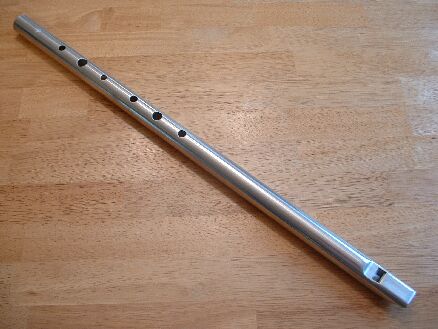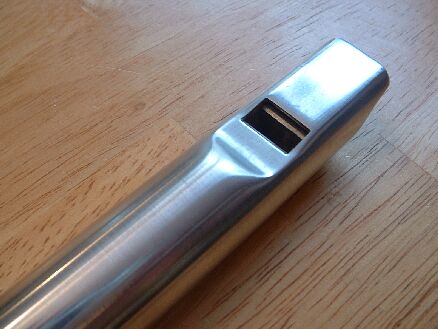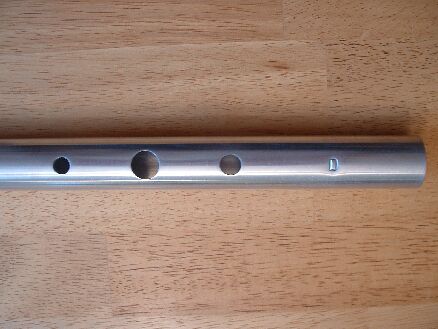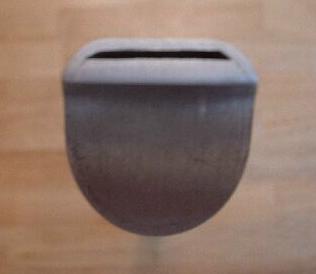Maker - Kerrywhistles (Phil Hardy) www.kerrywhistles.com
Material - Aluminum
Dimensions: Length - 22 7/8ths"
Distance between 1st and 3rd bottom holes - 3"
Diameter of 2nd hole from bottom - 1/2"
Bore - 7/8ths"
Weight - 7.5 oz
Price at time of review - While the OS series is obviously no longer in production, one may occasionally be found for sale used between $80 and $150 depending on the condition.
When
I first decided to create this site and started planning it's contents,
I had intended to review this whistle first. This was my very first Low
whistle, and is also the Low D I learned to play on. This is my baby, I
love it and pet it and call it George. (Well, not really, it's name is
actually Bob) As such, this also tends to be the whistle that I
initially compare all other low whistles to when I first play them.
This is not to say that I feel this whistle is the best Low whistle
ever, far from it. As you will see from the review below, it definitely
has it's weaknesses. But I would be a poor reviewer indeed if I did not
admit to my sentimental bias. Some of this bias is most likely due to
how long I have played it and subsequently how well I have come to know
its idiosyncrasies, to the point where I don't even have to think about
them anymore, playing it now just seems
effortless to me. In retrospect, I also feel that this whistle
seriously helped mold my conception/opinion as to what a low whistle
"should" sound like. So it was that I decided to try my hand at
reviewing other whistles first so that I could attempt some semblance
of impartiality. I leave it to you, gentle reader, to decide how
successful I have been.
I purchased this whistle from The Whistle Shop online around 2002, 2003. This was actually literally right when Kerrywhistles were coming out with the NR (New Range) Chieftain model, thus posthumously dubbing the Chieftains made before "OS" (Old Style). Kerrywhistles later came out with the third generation of Chieftains, the V3, in 2007. A very informative and interesting video history of the whole Chieftain whistle line can be viewed here on the Kerrywhistles website. It is entitled "Know your Chieftain" and is narrated by Phil Hardy himself.




I purchased this whistle from The Whistle Shop online around 2002, 2003. This was actually literally right when Kerrywhistles were coming out with the NR (New Range) Chieftain model, thus posthumously dubbing the Chieftains made before "OS" (Old Style). Kerrywhistles later came out with the third generation of Chieftains, the V3, in 2007. A very informative and interesting video history of the whole Chieftain whistle line can be viewed here on the Kerrywhistles website. It is entitled "Know your Chieftain" and is narrated by Phil Hardy himself.



Appearance:OK,
I admit that I have to start finding something to say besides "it looks
like a tube with holes in it", but man this whistle, well, looks like a
tube with holes in it. While Chieftains were originally loosely based
on the original Overton design, the head section is noticeably
different, being more part of the body itself than the Overton. In
Phils video history, he states that this is a result of trying to
create a whistle that could be mass produced in a factory. The spacing
of the bottom three holes is also different, the Chieftains first and
third holes are closer together and the second hole is more centerally
located between the first and third holes than on the Overton.
Tone: This whistle has a subtle, warm tone with just the right amount of breathiness mixed with a pure yet sonically complex tone. The low fundamental is pleasingly full if unfortunately just slightly low in volume. But, I find that this whistles quieter, warm tone makes it ideal for playing airs, and it especially sounds phenomenal when mic'd. It has a moderate amount of chiff, and definately sounds best when it is fully warmed up. Unfortuantely, it does take some effort to get it warmed up and then to keep it there. I have been told that this is due to the heat conducting properties of aluminum. (There is not enough room in this review to relate all the different methods and stories I have heard on how people have tried to keep their aluminum whistles warm)
Volume: I would describe the volume of this whistle as being moderate to quiet in comparison to other Low D's I have played. It is quieter in the first octave compared to the second, and from experience I can attest that the first octave usually cannot be heard in session environments. However, I don' t want to give the impression that the first octave is too quiet, as I certainly played other low D's that are much, much quieter. But, I have to admit that I've since played allot of low D's that are much louder as well.
Backpressure/air requirement:This whistle has moderate to low backpressure, and the air/breath requirement seems to be just slightly above average when compared to other low D's. The low end does take some breath support and control to make it sound it's best, but certainly not unreasonably so.
Responsiveness: Unfourtunately, this whistle can be just the slightest bit on the sluggish side (especially when compared to it's younger brother, the V3) and is probably not the best choice for super session speed reels. Ornaments can be easily executed and sound fine (they don't sound muddy in other words), they just don't sound as clear and crisp as on more responsive whistles. However, a side benefit of this is that the transitions between notes sound nice and smooth, where more reponsive whistles can sometimes have an abrupt, staccato attack, have to much chiff, or even squawk between notes. This again makes this Low D an ideal whistle for airs or even slow reels.
Clogging: This whistle does have a tendency to clog, especially when played cold. I would recommend using one of the anti-clogging methods such as waxed floss, soap or duponol.
Tuning: This whistle does have some tuning issues. In the second octave, all the notes from the F# on up were between 10 to 20 cents flat. (I am told that this can be a common issue with non-conical, cylindrical bored whistles) Both the F#'s and the C# are 20 cents flat as well, but the C natural was spot on using the standard OXXOOO fingering.
Sound clip: Doinna
Summary: If forced to compare this whistle with other "high-end" whistles, I might have to concede that there are some "better" sounding whistles out there. And if you twist my arm, I'll certainly admit that this is not the most responsive whistle available. But it's a good whistle dammit! But in the interest of fairness and objectivity, I will give this whistle six, ah, I mean four holes.

Tone: This whistle has a subtle, warm tone with just the right amount of breathiness mixed with a pure yet sonically complex tone. The low fundamental is pleasingly full if unfortunately just slightly low in volume. But, I find that this whistles quieter, warm tone makes it ideal for playing airs, and it especially sounds phenomenal when mic'd. It has a moderate amount of chiff, and definately sounds best when it is fully warmed up. Unfortuantely, it does take some effort to get it warmed up and then to keep it there. I have been told that this is due to the heat conducting properties of aluminum. (There is not enough room in this review to relate all the different methods and stories I have heard on how people have tried to keep their aluminum whistles warm)
Volume: I would describe the volume of this whistle as being moderate to quiet in comparison to other Low D's I have played. It is quieter in the first octave compared to the second, and from experience I can attest that the first octave usually cannot be heard in session environments. However, I don' t want to give the impression that the first octave is too quiet, as I certainly played other low D's that are much, much quieter. But, I have to admit that I've since played allot of low D's that are much louder as well.
Backpressure/air requirement:This whistle has moderate to low backpressure, and the air/breath requirement seems to be just slightly above average when compared to other low D's. The low end does take some breath support and control to make it sound it's best, but certainly not unreasonably so.
Responsiveness: Unfourtunately, this whistle can be just the slightest bit on the sluggish side (especially when compared to it's younger brother, the V3) and is probably not the best choice for super session speed reels. Ornaments can be easily executed and sound fine (they don't sound muddy in other words), they just don't sound as clear and crisp as on more responsive whistles. However, a side benefit of this is that the transitions between notes sound nice and smooth, where more reponsive whistles can sometimes have an abrupt, staccato attack, have to much chiff, or even squawk between notes. This again makes this Low D an ideal whistle for airs or even slow reels.
Clogging: This whistle does have a tendency to clog, especially when played cold. I would recommend using one of the anti-clogging methods such as waxed floss, soap or duponol.
Tuning: This whistle does have some tuning issues. In the second octave, all the notes from the F# on up were between 10 to 20 cents flat. (I am told that this can be a common issue with non-conical, cylindrical bored whistles) Both the F#'s and the C# are 20 cents flat as well, but the C natural was spot on using the standard OXXOOO fingering.
Sound clip: Doinna
Summary: If forced to compare this whistle with other "high-end" whistles, I might have to concede that there are some "better" sounding whistles out there. And if you twist my arm, I'll certainly admit that this is not the most responsive whistle available. But it's a good whistle dammit! But in the interest of fairness and objectivity, I will give this whistle six, ah, I mean four holes.